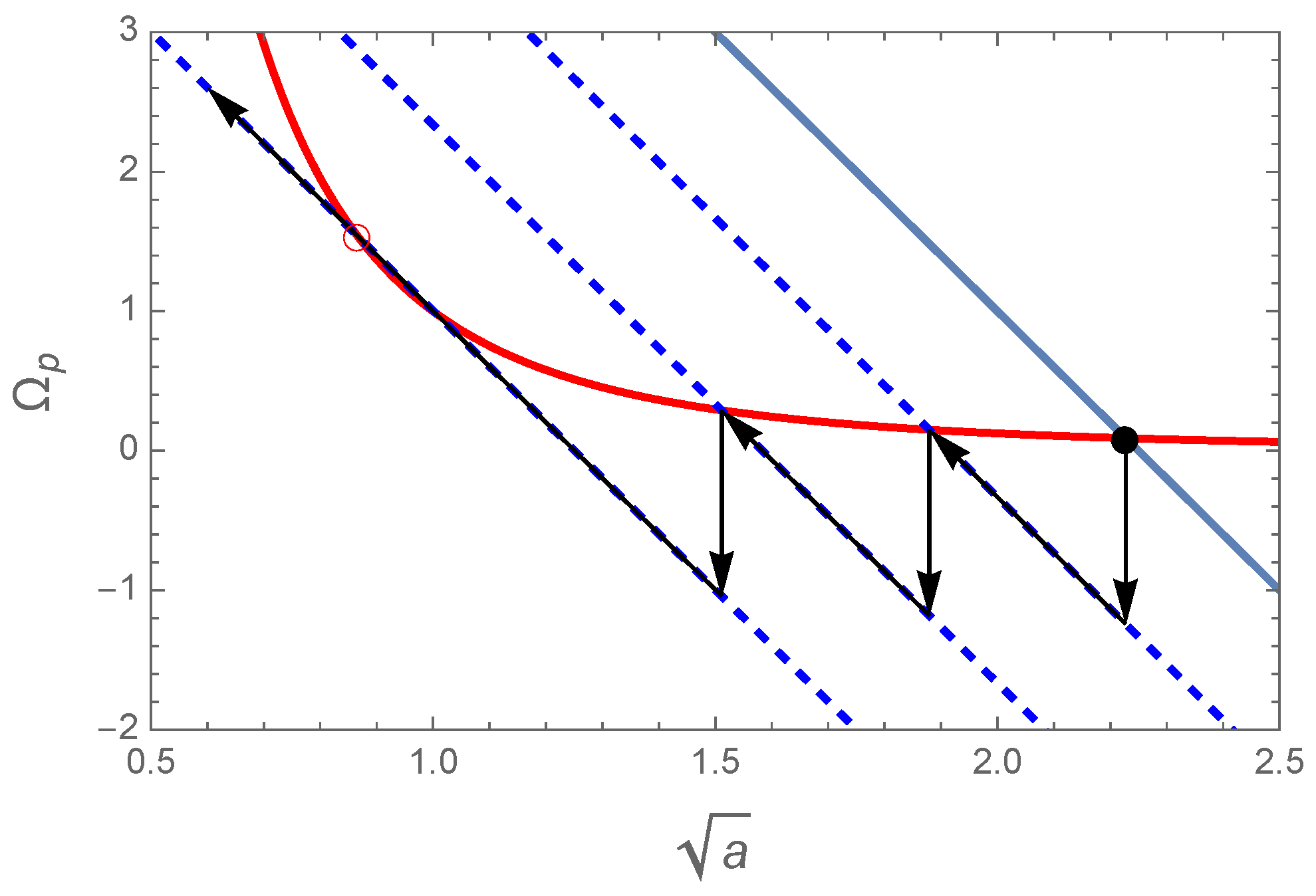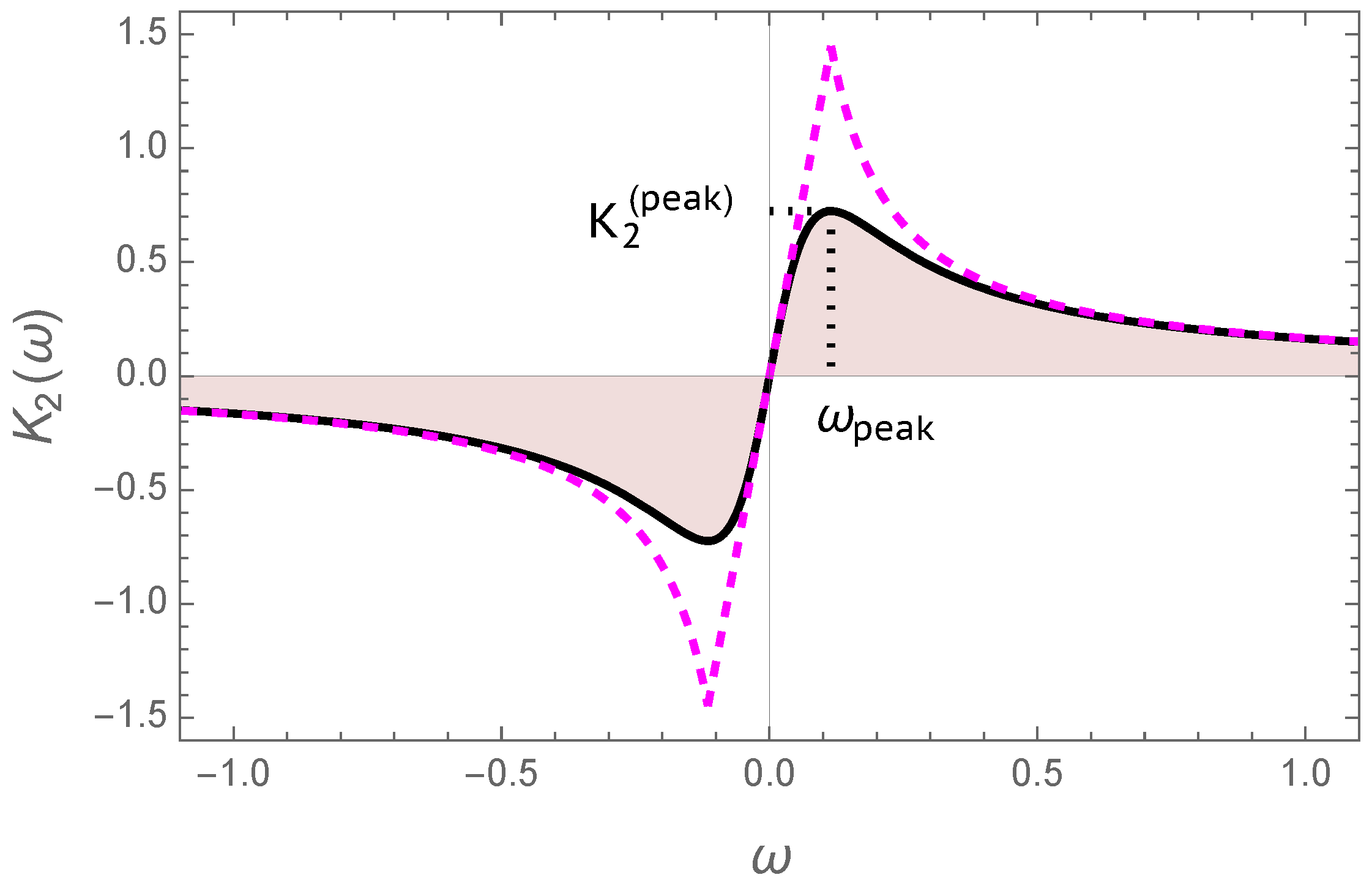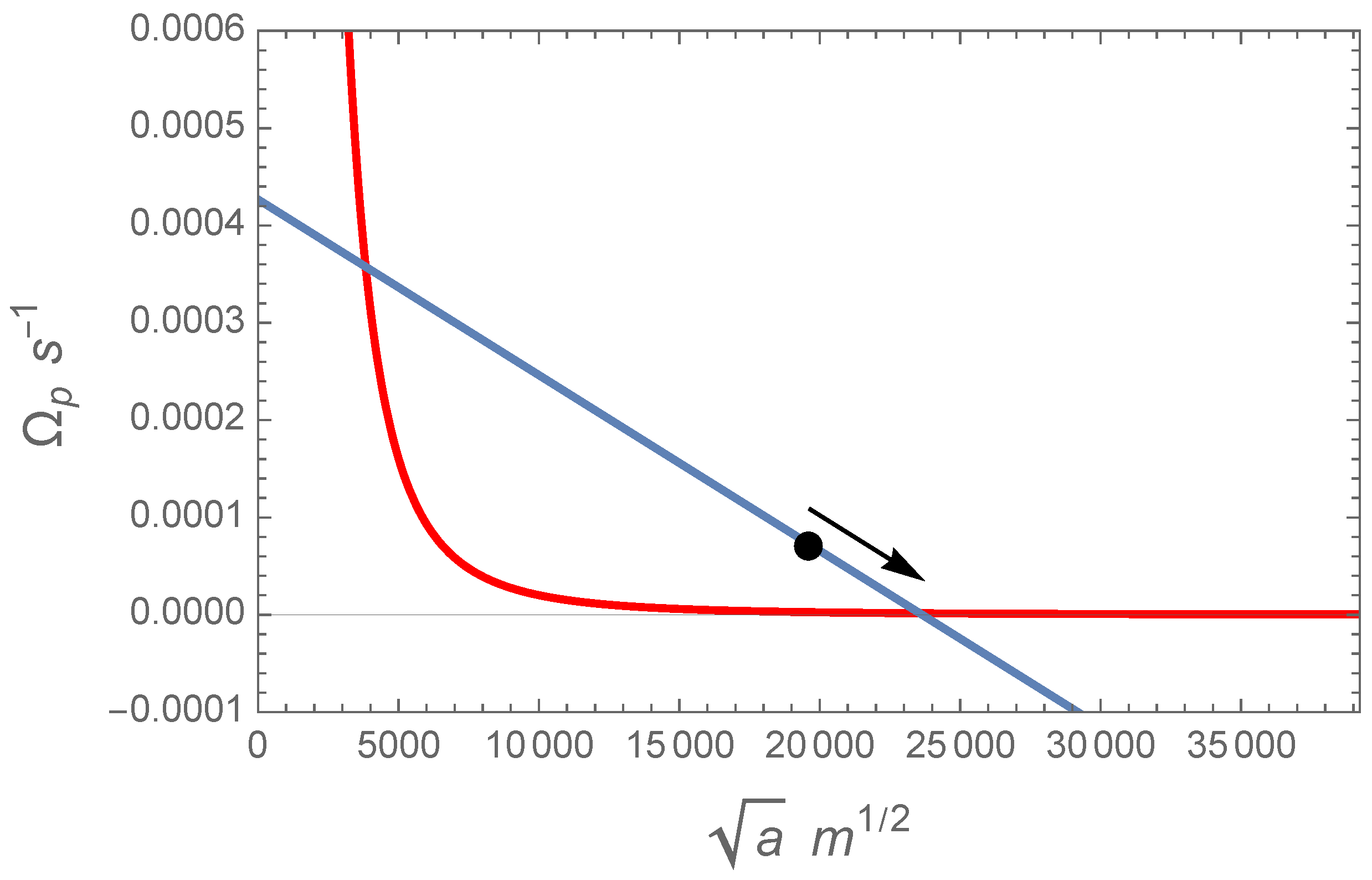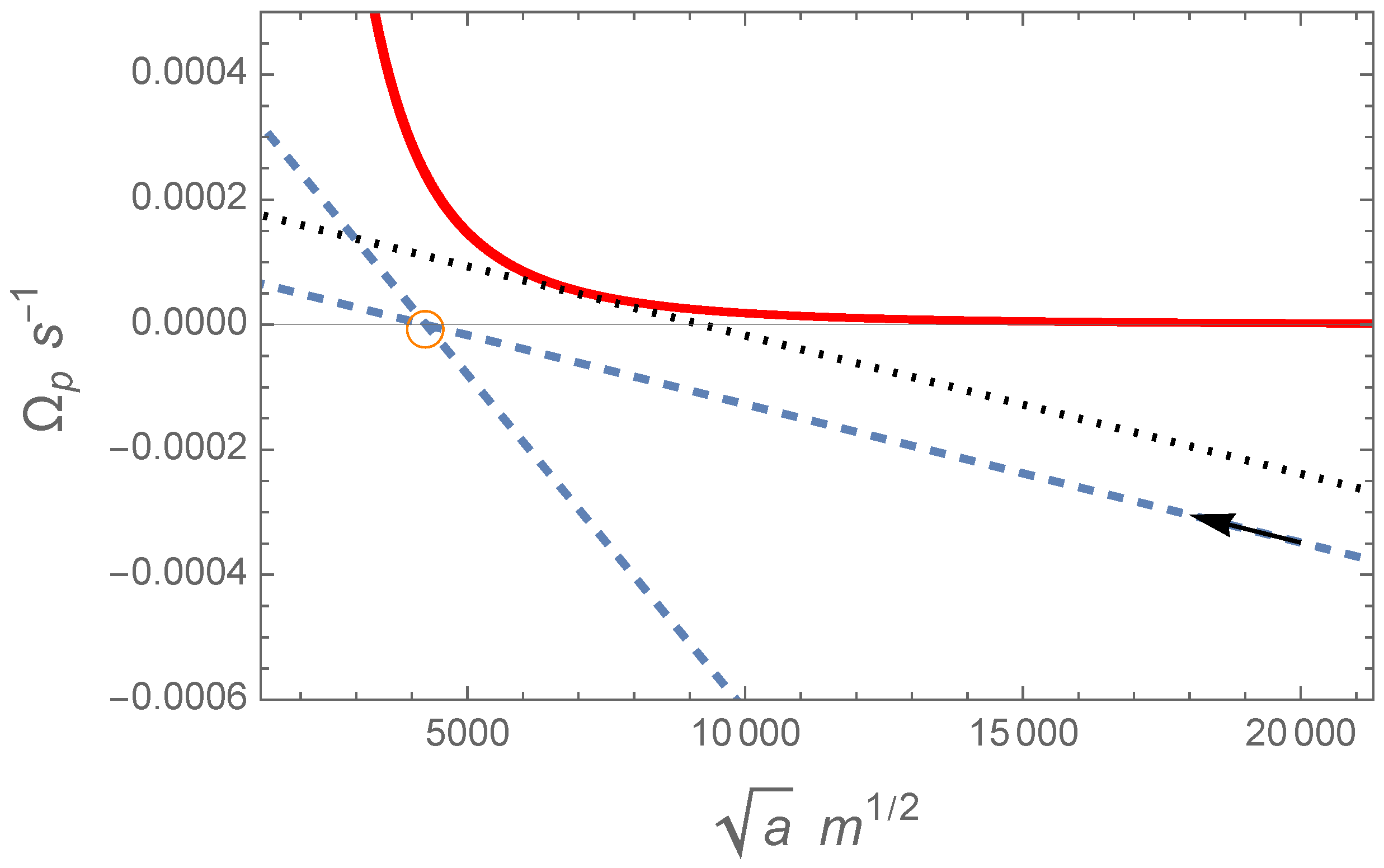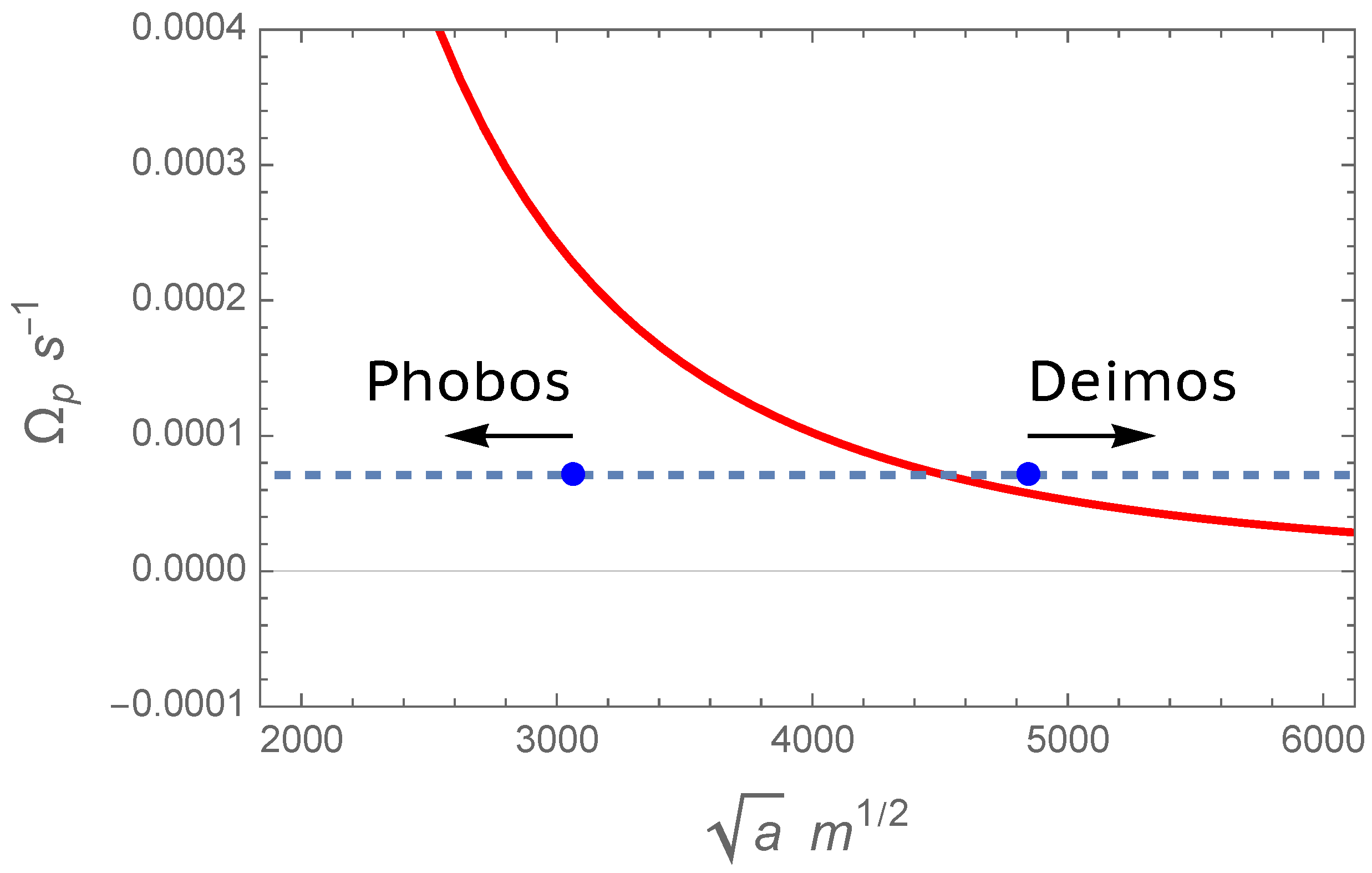1. Introduction
There are two pathways for tidally interacting planet–moon systems to achieve complete mutual synchronisation, defined as an equilibrium state where both partners’ angular rotation rates equal the orbital mean motion.
One path is for secularly expanding pairs, such as the Earth–Moon system today. For this expansion to start, the planet’s rotation must initially be faster than the orbital motion of the moon; equivalently, the initial separation of the bodies must be larger than the synchronous radius. Also, the initial eccentricity should not be too high [
1,
2]. This initial setting ensures that the principal tidal bulge raised on the planet by the moon is aligned (up to libration) with the instantaneous direction toward the moon, and that the planet is despinning, allowing for the angular momentum to be transferred from the planet’s rotation to its orbit.
The other path is for initially closer satellites with orbital periods shorter than the planet’s rotation period. The orbital momentum is then transferred from the orbit to the planet’s rotation due to the torque from the lagging tidal bulge on the planet. The best known example of this option is the Mars–Phobos pair. The case of a retrograde moon, such as Triton [
3] or the hypothetical satellite of Venus [
4], also belongs in this category.
For close-in planets with moons, the significant presence of the star–planet interaction adds layers of complexity to these scenarios, providing either accelerating or counter-directed tidal action on the planet [
5].
When the moon is sufficiently massive and close to the planet, the tidal action from it overwhelms the torque on the planet from the star. Two outcomes of secular tidal evolution are then possible: in one, the moon crosses the Roche limit; in the other, the planet’s rotation rate evolves toward an equilibrium state, a spin–orbit resonance with the moon.
This topic was first addressed in the pioneering work by Darwin [
6], who found that, for a conserved angular momentum of a two-body tidal system, at most two synchronous configurations are possible, with the one of lower energy being stable. A century later, the problem was addressed again by Hut [
7], who investigated a primary mass rotating at a rate
and a point-like secondary mass describing an orbit with a mean motion
n, inclination
i, and eccentricity
e. He demonstrated that, rigorously speaking, the only tidally stable spin–orbit state is the one satisfying the conditions of circularity (
), coplanarity (
), and corotation (
). Conditions of stability were obtained via eigenvalues of the energy Hessian in the space of total angular momentum and
n for an idealised two-body system.
Our study is a development of this problem, aimed at defining the initial conditions of the observable parameters (the semimajor axis a and the planet’s rotation rate ) that can result in configurations remaining transiently stable for sufficiently long periods in realistic three-body systems. We derive analytical inequations and specify the dualism of synchronous configurations (long-term stable versus inherently unstable) from first principles, irrespective of the specific tidal model. Our results can be directly applied to a variety of solar or exoplanet configurations, as illustrated by several examples.
Within realistic tidal models for terrestrial bodies [
8], higher-order spin–orbit resonances can emerge at 3:2, 2:1, and even higher commensurabilities [
9]. This can occur, probabilistically, even if the amplitude of the tidal torque in the vicinity of a given resonance is somewhat smaller than the secular torque caused by the finite eccentricity and the triaxial shape of the moon. Assuming the current eccentricity value, the moon was more likely to be captured in a 3:2 spin–orbit state than to miss it during the course of tidal despinning [
10,
11]. A higher spin state, however, is only a local equilibrium, because a sufficiently strong external perturbation (e.g., an impact) or a partial meltdown of the moon’s crust [
12] can drive the moon out of this state.
Our goal is to adumbrate a set of initial conditions that must be met by a tidal binary to make tidal synchronism attainable. These conditions are independent of the planet’s tidal properties and rheology. We present calculations for specific planet–moon systems (Earth and the Moon, Pluto and Charon, Mars and its satellites, and Venus and its hypothetical presently extinct moon Neith) to constrain dynamically plausible formation and evolution scenarios.
2. Angular Momentum Exchange
This discussion expands upon the ideas proposed by Makarov and Efroimsky [
5].
We consider a planet of mass M and radius R and a moon of mass and radius . Their maximal moments of inertia are and , where and are dimensionless moment of inertia (MOI) coefficients. As customary, a and n are the semimajor axis and mean motion.
For mathematical convenience, we shall always assume the mean motion to be positive, , while the rotation rate of the planet will be positive or negative, depending on whether the moon’s orbit is prograde or retrograde.
To single out the principal aspects of the dynamics, three simplifications are adopted:
- (a)
The moon’s spin angular momentum can be neglected.
This premise is reasonable, even when the partners’ masses differ by less than an order of magnitude. For example, the spin angular momentum of Charon is about of the orbital angular momentum of the system and about of the spin angular momentum of Pluto.
- (b)
The moon’s orbit is near-circular, and terms may be omitted.
We would add that the evolution of
e is a nontrivial issue, as the direction of this evolution is sensitive to the partners’ rheologies and, therefore, not immediately apparent.
1 However, even when
e is predicted to approach zero in a simplified two-body model with tides included, a small but finite value of
e may persist in a real-world scenario due to the influence of external bodies and/or a resonance between the orbital motion and the irregular shape of the host planet. Despite these complexities, we take the liberty of assuming that
e is small and neglects the terms of order
.
- (c)
The moon’s orbital inclination i relative to the planet’s equator is small, as is the moon’s obliquity relative to its orbit. Therefore, all terms of order or may be dropped.
Neglecting the spin angular momentum of the moon, and ignoring the
,
, and
terms, the conservation of angular momentum reads as follows (Appendix D in Makarov and Efroimsky [
5]):
where
is the planet’s rotation rate. Note that this equation holds for positive or negative time derivatives in the left-hand part. As was explained in
Section 1, there are two distinct evolutionary paths characterised by either both
and
positive (implying orbital decay and the planet’s spin-up) or both derivatives negative (implying orbital expansion and the planet’s spin-down). Implicitly, the semimajor axis
a is a function of time.
In Equation (
1), it is convenient to remove
in favour of
. From
follows
, the insertion whereof into Formula (
1) entails
where the dimensional factor
X defined through
may be interpreted as a measure of the angular momentum exchange rate.
Introducing the combination
of the initial conditions, we observe that a direct integration of Equation (
2) over time produces
where
C appears as an integration constant. Therefore, the planet’s rate of rotation
is a linear function of
with a negative slope.
In these variables, the synchronisation condition
translates to a cubical hyperbola in terms of
:
Thus, we obtain two functions, shown in
Figure 1.
The function
, given by Equation (
5) and depicted by a blue straight line, represents angular momentum conservation, a condition that must be satisfied by each physical history. Different straight lines in the figure correspond to different values of the angular momentum carried by the system. The location and slope of each such line depends, via
X, on the parameters of the system, and, via
C, on the initial conditions.
The function
, given by Equation (
6) and shown by a red cubical hyperbola in the figure, represents the planet’s angular velocity synchronised to the orbital motion with a semimajor axis
. This curve is only defined by the total mass, not by the initial conditions.
Not every physical history (i.e., not every possible straight line with a fixed slope in
Figure 1) can intersect the red curve. In other words, not every set of the parameter values and initial conditions sends the system towards synchronism. When the initial conditions and parameter values are such that curves (
5) and (
6) do not intersect, this means, physically, that the planet’s rotation rate cannot catch up with the mean motion on the contracting orbit, and the system cannot be synchronised.
The situation is borderline when lines (
5) and (
6) are tangent in a single point. This brings up two conditional equations:
where the constant
is the specific value of
C corresponding to the borderline case. Formula (
7) renders
which, in combination with expression (
3), entails
Synchronisation is possible if the actual constant of integration
C exceeds or equals the borderline value
:
where we invoked definitions (
3), (
4), and (8).
The condition (
9) of synchronism attainability depends on the parameter values and the initial conditions
and
. It is valid for any scenario of tidal evolution, including the case of an initially retrograde rotation (
).
In the borderline situation where the parameters and initial conditions are picked such that the weak inequality (
9) becomes equality,
, the moon becomes synchronous in a single point
. In
Figure 1, this situation is illustrated with the point where a straight line is tangent to the red cubical curve. The equilibrium at the tangent point is unstable under a perturbation decelerating the planet’s spin (e.g., a tidal torque exerted on the planet by the star) or reducing the moon’s orbit. Depicted with downward black arrows, decelerating perturbations are compensated by the action of moon-generated tides (shown with arrows pointing to the left and up). This stabilisation mechanism, however, will not work in the tangent point. We thus observe that the moon can reach the tangent point only by moving from right to left, i.e., from an initially wider orbit. As can be seen, the moon will not pause if perturbed, and will keep spiraling down. It is therefore highly unlikely to find a planet–moon system in this transient state.
The values of the synchronous radii can be found from Equation (5) by setting
in it. In terms of the variable
this renders the quartic equation
which has four roots. Three options are available: (a) none of the roots are positive real, meaning that synchronisation is impossible; (b) only one (nonidentical) root is positive real, corresponding to the marginal tangent point condition (
7); or (c) only two roots are positive real, defining the two synchronous states.
The considerations above are also valid for spin–orbit resonances higher than the synchronous 1:1 state addressed in this paper. Indeed, sufficiently cold, inviscid planets with a moon in an orbit of finite eccentricity can be captured in such a nonsynchronous resonance (e.g., 3:2) if certain conditions are fulfilled on the mass and orbit separation. The only difference would be an additional factor 3/2 in Equation (6), which would shift the cubical hyperbola in
Figure 1 upward. This change would set more stringent initial conditions to achieve the resonant state (a higher initial rotation rate
) and would favour more massive satellites. Generally, a pair of distinct equilibrium states emerges as well, with the inner state being intrinsically unstable.
3. The Stability of Synchronism, in Local Terms
Results that are consistent with the above findings can be obtained using a different method. Ignoring the tides in the satellite, consider only the contribution from the tides in the planet into the tidal rate of the semidiurnal axis. In this contribution, the quadrupole semidiurnal term is
where
is the quality function and
is a short notation for the principal (semidiurnal) tidal Fourier mode
. The superscript “
” denotes “planet, quadrupole, semidiurnal”.
To explore the stability of this term under the small variations of planet–moon separation, we calculate its full (not partial) derivative with respect to
a at a point of synchronism where
. As demonstrated in
Appendix A,
the derivative
is given by expression (
1). In
Appendix A, we explain that the derivative
is positive at the point of spin–orbit resonance crossing for a planet of the Maxwell rheology. This conclusion is valid for all realistic bodies.
2 From this, we deduce a concise and practical criterion of stability:
Synchronism is stable if ; unstable otherwise.
We term this criterion “local” because it bears no explicit dependence on the initial conditions (although it refers to them indirectly, using the assumption that a synchronous state does exist). The “local” criterion, of course, agrees with the “global” one derived in the preceding section and illustrated by
Figure 1. Indeed, in this figure, stable (unstable) configurations correspond to a situation where the absolute value of the slope
of a straight line exceeds (falls short of) the absolute value of the slope
of the cubical curve, at the point of the curves’ crossing. In other words, any perturbation of
from the inner point of equilibrium, independent of its sign, sends the system on a new linear trajectory with the same direction and the same negative slope, driving the system father away from the red curve in
Figure 1, where it could regain synchronism. For example, a spontaneous or externally incited acceleration of the rotation rate puts the system on a linear tract leading downward and to the right. The opposite situation is observed in the stable outer point of equilibrium, where an upward perturbation in
sends the system toward a new and slightly updated state of synchronism. The same consideration is valid for a perturbation of
a. Thus, the restoring action, which is the necessary condition of stable equilibrium, is only realised in the outer point of intersection. It can be demonstrated that, for a vanishing eccentricity and a neglected spin angular momentum of the secondary, our results, although obtained by a different method, do agree with those derived by Darwin [
6] and Hut [
7].
4. Generalisation to the Case of 3:2 Spin-Orbit Resonance
While the method of stability analysis described in
Section 3 is generic and, specifically, applicable to an arbitrary spin–orbit resonance, here we shall illustrate how it works in the 3:2 case.
Equation (
A1) from
Appendix A comprises the quadrupole inputs into
of orders up to
. To analyse the behaviour of the system in the vicinity of the Mercury-like 3:2 spin state, we need to keep the term containing
, as well as the leading term responsible for the bias, which is the
part of the semidiurnal input:
Consider that this expression and all the subsequent analysis are valid for sufficiently small eccentricities because the series for over the powers of e is notorious for its slow convergence because of large coefficients accompanying the higher-order terms in .
The derivative of the above expression reads
In the
resonance, the term
vanishes, and we result with
Since
, the first term in square brackets is always negative and is working to make the equilibrium stable. For realistic rheologies,
is positive, see e.g., Equation (
A5). Therefore, for
, the third term also is negative and, therefore, stabilising.
The case of the second term is nontrivial. For semimolten viscous objects, the frequency
may, in principle, reside to the left of the maximum of the
function given by Equation (
A5) and depicted in
Figure 2. In this case, the value of the derivative
is positive, and the second term in Equation (
16) is negative for
. Summing up, for
, all terms are negative and the 3:2 spin state is stable. For
, the result is likely to be the same, because the now-positive third term is unlikely to beat the first two (aside from
, it contains
which is not too large for semimolten bodies.)
For cold terrestrial bodies, the slope of
near
is extremely steep. At the same time, for such bodies the value
resides well to the right of the peak in
Figure 2, so the derivative
is negative, and the function
is slowly falling off as
,
, for Andrade mantles, or as
for Maxwell mantles; see Equation (20) below. Under these circumstances, the last term in Equation (
16), despite being proportional to
, is likely to overpower the penultimate term. Given that the first term in square brackets is negative, we can say that, in this situation, the condition
serves as a warranty of the 3:2 spin state being stable.
To sum up, we may expect that, in realistic settings, the condition ensures the stability of the 3:2 spin–orbit resonance. Whether or not the resonant state is stable for needs to be explored on a case-by-case basis.
5. Analytical Approximation of the Rate of Spin-Orbital Evolution
The tidal quality function of a homogeneous spherical Maxwell body is given by Equation (
A5). This function has the shape of a kink, as in
Figure 2.
It ensues from Formula (
A5) that the maximum and minimum of the kink are attained at
and assume the values
3 The quality function
is near-linear between the peaks:
and falls off as about
outside the said interval:
where the factor
is twice the actual maximum given by expression (
18).
For rigid and inviscid planets like the Earth,
is close to zero, so the linear segment of the function between the peaks is steep, and capture into the main spin–orbit resonance happens relatively quickly once the system transcends the peak frequency. The subsequent orbital evolution is then governed by the linear-in-frequency tidal reaction (
19) known as the Constant Time Lag (CTL) model. This regime has often been addressed in the literature, and we shall not dwell on it—especially because the resonance is very narrow for inviscid planets and is effectively a synchronous state with free librations that decay rapidly.
The protracted phase described by Equation (20) is of a greater interest for this study, because this phase comprises the dynamics of approach to synchronism from a distant initial state. Combining Equation (20) with expression (
12) we obtain, in the quadrupole approximation (and in the leading order of
e),
where
Using the angular momentum conservation law in the form of Equation (
5), we express
via
and arrive at the following differential equation:
where we again use a shorthand,
. This equation leads to the following solution:
where
B is a constant of integration. By setting
, it is easily linked to the initial condition
.
Computations with
Mathematica show that, for realistic parameter values, Equation (
24) has fourteen roots, of which only two happen to be real outside a close vicinity of the synchronous resonance, and only one (root number 14) turns out to be positive. This equation allows us to calculate the value of
a at any time in the past or future of the initial state
, as long as the planet–moon system remains outside the synchronous spin–orbit resonance, and insofar as the eccentricity is small.
4 It also enables us to calculate the time required for the system to evolve from an initial condition
to some
:
For Pluto’s mean radius and density, and with the rigidity assumed to be typical of ices,
Pa, Equation (
A6) gives
, wherefrom
. Assuming
, we find from Equation (
24) that with the initial state
m
1/2, Charon would have descended to
m
1/2 in the first 1 Myr. With the assumed parameters, it would take the Pluto–Charon system 105 Myr to reach the current spin–orbit equilibrium.
6. The Impact of Tidal Perturbation Due to the Star
A two-body planet–moon tidal system is a simplified model that neglects the influence of the star. In real star–planet–moon systems, this simplification is not always acceptable, primarily due to a secular torque acting on the planet from the tidal bulge raised on it by the star. When the planet’s rotation is not synchronised with the moon’s mean motion, the star-generated torque on the planet changes the slope of the tidal evolution track. However, if the planet becomes successfully synchronised by the moon, what is the net effect of the remaining secular torque from the star?
Figure 1 illustrates this dynamical consideration graphically. In the chosen axes,
and
, given in arbitrary units, the locus of the synchronisation condition is represented by the red curve, while a possible evolutionary track due to the tides from the moon alone is shown by the solid blue line. The black disk marks the position of the long-term stable tidal equilibrium when the planet rotates synchronously with the orbital motion of the moon. The system can reach this equilibrium from either direction along the solid line. Unless the planet is synchronised by the star, the planet’s orbital motion is normally expected to be slower than its spin. Therefore, the star gives rise to a leading tidal bulge on the planet, unless the planet’s rotation is retrograde. This effects acts to decelerate the planet’s rotation. Assume, within a toy dynamical model, that this external action is an impulse, which instantaneously reduces
, as shown with a downward arrow originating from the black disk. Since the actual rate of rotation is now slower than the synchronisation value, a tidal torque from the moon emerges, which moves the system along the new linear track (the first dashed line below) up and to the left, until the new point of intersection is attained and the synchronisation equilibrium is restored. A new braking impulse from the star starts another cycle of evolution, as shown with the corresponding pair of arrows. This process continues until the newly acquired tidal track intersects the cubical curve in a single tangent point (shown with a red circle). As we previously noted, this equilibrium is unstable, and the system will continue to shrink forever.
To transit from this toy model to actual physical behaviour, let us make the braking impulses from the star continuous and infinitesimal. It is obvious that, as long as the tidal action from the moon is stronger than that from the star, the net effect will be a secular drift of the system from the initial point (black disk) along the cubical curve towards the critical tangent point (red circle). The braking tidal torque on the planet from the star is transformed by this mechanical configuration into a braking moment on the moon and faster rotation of the planet via the stronger tidal response from the moon. If the tangent point is ever reached, the planet becomes suddenly liberated from the synchronisation lock, and the moon will commence its final descent. Thus, in the very long run, a synchronisation state is transient, with the system drifting along the cubical curve track towards the single point of unstable equilibrium, and then along the linear track towards the final downward spiral. If such previously synchronous moons are ever found, the current
state can be used to compute the slope
X in Equation (
3) and, therefore, to estimate the moon’s mass.
The impact of the tides raised by the star in the general non-equilibrium configuration of an expanding orbit and prograde motion (the Sun–Earth–Moon case depicted in
Figure 3) is also a systematic perturbation of the planet’s spin, which is aligned with the braking moment from the moon. The trajectory will be slightly bent downward in this Figure. The main effect is that the point of stable equilibrium will be reached sooner and at a slightly shorter separation.
8. Conclusions and Questions
In neglect of the angular momentum of the moon, and for small eccentricity and obliquities, we have derived a simple constraint on the physical parameters of a planet–moon system and the initial planet’s spin rate and orbital separation, which ensures a possibility of planet’s synchronisation with the tidally evolving orbit. This condition is universal, and bears no dependence upon the planet’s internal structure or tidal dissipation model. It is applicable to dwindling systems, as well as tidally expanding orbits and cases of initially retrograde motion. The utility of this condition has been illustrated through examples of several well-known planet–moon pairs in the solar system.
We derive a constraint such that, when satisfied, the system can become completely synchronous in principle, although not always. When the condition is met, there are two possible values for the synchronous radius—those corresponding to a low-energy and a high-energy states of rotational equilibrium. The former is intrinsically unstable, while the latter is permanently stable. This is seen from the direction of angular momentum exchange in the axes
in
Figure 1 and
Figure 3. If an evolutionary track, which is a straight line with a negative slope, does not intersect the cubical curve representing synchronous states, the system always moves to the left and up; that is to say, the moon spirals down onto the planet. The same is true for the marginal case when the track is tangent to the hyperbola in one point, making this equilibrium intrinsically unstable. When the track intersects the cubical curve in two points, the segment between these points has the tidal torque directed toward a lower spin rate and a higher
a. Therefore, for the stable high-energy synchronisation state, the tidal action provides a restoring torque whenever an external perturbation, independent of its direction, drives the system out of this state. The Earth–Moon system is heading toward its stable point of synchronism. The Mars–Phobos–Deimos system is diverging away from the low-
a, unstable point of equilibrium, which suggests a super-synchronous configuration if they split from a single progenitor body or from a horseshoe co-orbital binary.
The Pluto–Charon pair is probably permanently captured into a stable, high-energy state of synchronism. Our analysis raises the question whether this pair arrived at this current state from an initially narrower configuration (as is commonly assumed) or from a wider orbit. The latter option would not require Pluto to have an initial retrograde spin with respect to the solar system angular momentum. It would be more conformal to the proposed external capture of Charon from an independent heliocentric orbit, rather than the giant impact scenario. Pluto and Charon would represent the case of a successful synchronisation of a small planet by an externally captured moon.
The hypothetical retrograde moon of Venus represents a case when our derived condition is not satisfied, and the moon inevitably spirals down onto the planet. Our specific calculations reveal that it is not the mass of Neith that was the critical factor for this scenario, but rather the initial spin rate of Venus in the prograde sense. A slow prograde spin rate with a period of ∼35 h would trigger the synchronisation condition for a retrograde moon of moderate mass, which would still be orbiting Venus today.
The method of derivation of the local criterion provided in
Section 3 can be generalised for an analysis in which other effects are included: a finite eccentricity value, higher-than-quadrupole terms, an input from the planet-caused tides in the satellite, etc. For example, this analysis can be applied in the case of moons which are not only tidally synchronised with the host planet, but are themselves in orbital resonance (like the Galilean moons). To explore the stability of the synchronous state of such a moon, one should also include into expression (A2) for
the leading terms emerging due to the interactions between these moons. An example of application for the case of 3:2 spin–orbit resonance is provided in
Section 4.
Our main results may find interesting applications in the studies of exoplanets. Owing to the fast-paced technical progress in space and ground-based observations, astronomers may be on the brink of major discoveries concerning rotational dynamics of exoplanets. If asynchronous exoplanets are detected, the option of tidal synchronisation by an exomoon should be considered, given the spectacular examples in our solar system. The currently identified candidate exoplanet–exomoon system include Kepler 1708b-i [
36] and Kepler 1625b-i [
37], although the latter case has been disputed [
38]. In both cases, the suggested satellites of Uranus or Neptune mass orbit Jupiter-sized planets at a significant distance from their host planets. This configuration is closer to the Pluto–Charon case. Indirect evidence of a volcanic or evaporating moon was found in phase-shifted sodium lines in the spectrum of the WASP-49 A system [
39], which would represent, if confirmed by follow-up observations, a rather improbable case of a rocky moon jammed in the narrow survival niche of the hot Jipiter WASP-49 Ab [
40].
